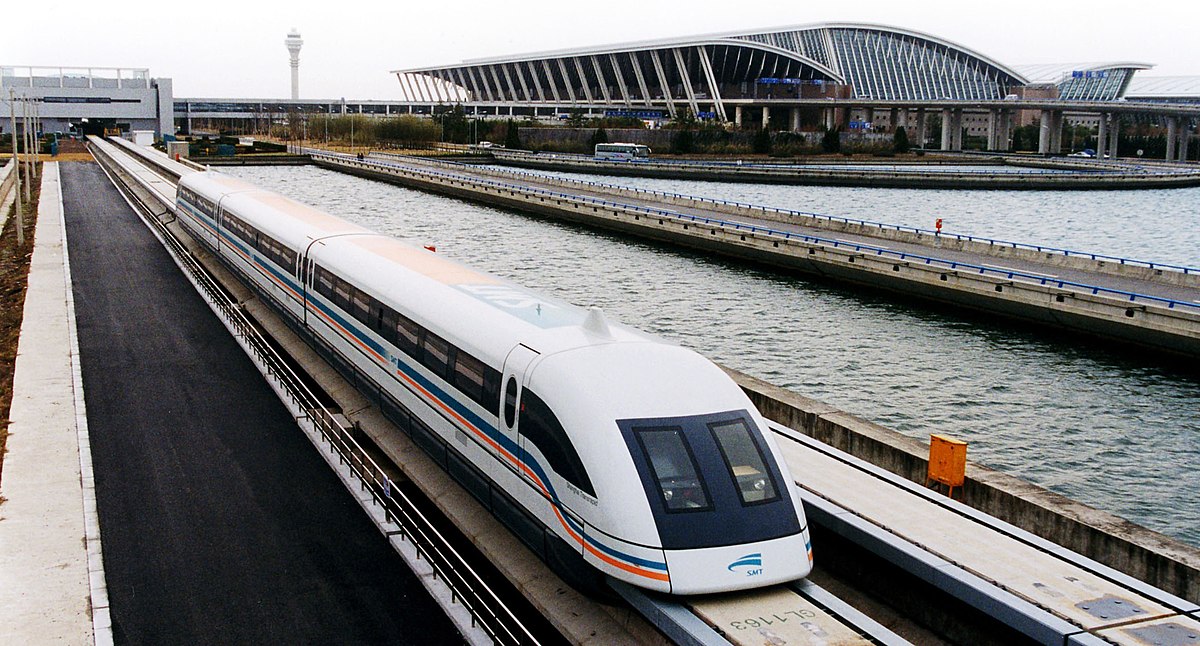
Maglev trains, short for "magnetic levitation" trains, represent a revolutionary advancement in transportation technology. Unlike traditional trains that rely on wheels and tracks, maglev trains float above the guideway, propelled by powerful magnetic forces. This innovative mode of transportation offers numerous advantages, including increased speed, reduced friction, and enhanced energy efficiency. As a result, maglev trains have captured the imagination of engineers and commuters alike, promising to redefine the future of travel.
In this article, we will delve into 19 fascinating facts about maglev trains, exploring their history, technology, benefits, and potential impact on the transportation industry. From their inception to their impressive speed records, from the science behind their operation to their environmental advantages, we will uncover the captivating story of maglev trains. Join us on this journey as we unravel the mysteries and marvels of these extraordinary vehicles that defy gravity and push the boundaries of modern transportation.
Key Takeaways:
- Maglev trains use magnets to float above tracks, reaching incredible speeds of up to 375 mph. They offer a smooth and quiet ride, revolutionizing urban transportation with their energy efficiency and potential for intercity travel.
- The world’s fastest commercial maglev train operates in Shanghai, reaching 267 mph. Despite logistical challenges, maglev technology continues to advance, inspiring awe and fascination worldwide as a glimpse into the future of sustainable transit.
The first commercial maglev train began operation in 1984.
The keyword "maglev trains" refers to magnetic levitation trains, which use powerful magnets to float above the tracks, eliminating the need for traditional wheels. The first commercial maglev train, known as the Linimo, commenced operations in Aichi, Japan, in This marked a revolutionary milestone in the realm of transportation, as maglev technology offered a promising alternative to conventional rail systems.
Maglev trains can reach staggering speeds.
One of the most remarkable features of maglev trains is their exceptional speed capabilities. These trains can reach astonishing speeds, with the record currently standing at 375 mph (603 km/h) achieved by the L0 Series maglev train during a test run in This velocity surpasses that of traditional high-speed trains, making maglev technology a compelling prospect for the future of rapid transit.
The principle behind maglev technology is electromagnetic propulsion.
At the heart of maglev trains lies electromagnetic propulsion, a cutting-edge concept that propels the vehicles forward. The trains are equipped with powerful magnets, with the track also featuring magnetic elements. Through electromagnetic repulsion and attraction, the train is propelled along the track, resulting in a smooth and efficient mode of transportation.
Maglev trains offer a remarkably smooth ride.
Compared to conventional trains, maglev trains provide an incredibly smooth and quiet ride. This is attributed to the absence of physical contact between the train and the track, as well as the advanced suspension and stabilization systems employed in maglev technology. Passengers can enjoy a serene journey, free from the jolts and vibrations commonly associated with traditional rail travel.
The world’s fastest commercial maglev train operates in Shanghai.
Shanghai is home to the world's fastest commercial maglev train, the Shanghai Maglev Train. This marvel of engineering connects Shanghai Pudong International Airport to the city's metro system, hurtling passengers along at a remarkable top speed of 267 mph (430 km/h). The implementation of this high-speed maglev service has significantly reduced travel times for commuters and visitors to the bustling metropolis.
Maglev trains have the potential to revolutionize urban transportation.
With their unparalleled speed and efficiency, maglev trains hold the potential to revolutionize urban transportation networks. By significantly reducing travel times and offering a sustainable mode of transit, these advanced trains could alleviate congestion in densely populated urban areas, presenting a compelling solution to modern transportation challenges.
The construction of maglev tracks requires meticulous precision.
The construction of tracks for maglev trains demands meticulous precision to ensure optimal performance and safety. The alignment and placement of magnetic elements along the track must adhere to stringent standards, and the track itself must exhibit exceptional smoothness to facilitate the seamless operation of maglev trains at high speeds.
Maglev trains are propelled without traditional engines.
Unlike conventional trains powered by locomotive engines, maglev trains are propelled without the use of traditional engines. Instead, the electromagnetic propulsion system propels the trains along the track, offering a groundbreaking approach to transportation that reduces reliance on fossil fuels and minimizes environmental impact.
The development of maglev technology has sparked global interest.
The advancement of maglev technology has sparked global interest, with various countries exploring the potential of implementing maglev train systems. From the United States and Germany to Japan and China, ongoing research and development initiatives are aimed at harnessing the benefits of maglev technology to enhance transportation infrastructure and connectivity.
Maglev trains are renowned for their energy efficiency.
In addition to their impressive speed and performance, maglev trains are celebrated for their exceptional energy efficiency. The use of electromagnetic propulsion and the absence of friction between wheels and tracks contribute to reduced energy consumption, positioning maglev technology as a sustainable and eco-friendly mode of transportation.
Maglev technology presents exciting possibilities for intercity travel.
The advent of maglev technology presents exciting possibilities for intercity travel, offering the potential for swift and seamless connections between major urban centers. With the capability to traverse long distances at unprecedented speeds, maglev trains could redefine the concept of intercity commuting, enhancing accessibility and connectivity on a global scale.
The development of maglev trains requires substantial investment in infrastructure.
The development and implementation of maglev train systems necessitate significant investment in infrastructure, including the construction of specialized tracks, stations, and maintenance facilities. Despite the substantial initial outlay, the long-term benefits of maglev technology in terms of transportation efficiency and environmental sustainability make it a compelling consideration for urban and intercity transit networks.
Maglev trains boast impressive safety features.
Maglev trains are equipped with state-of-the-art safety features to ensure the well-being of passengers and crew. From advanced collision avoidance systems to robust fail-safe mechanisms, these trains prioritize safety as a fundamental aspect of their design, offering peace of mind to those traveling at high speeds aboard these innovative vehicles.
The environmental impact of maglev trains is relatively low.
In comparison to traditional modes of transportation, maglev trains exhibit a relatively low environmental impact. The reduced energy consumption, minimal noise pollution, and absence of direct emissions associated with maglev technology contribute to a more sustainable and eco-friendly transportation solution, aligning with global efforts to mitigate the effects of climate change.
Maglev technology continues to undergo advancements and refinements.
The field of maglev technology is characterized by ongoing advancements and refinements, driven by a commitment to enhancing performance, efficiency, and safety. Research and development efforts are focused on optimizing maglev systems, exploring new materials, and refining operational processes to further elevate the capabilities of these remarkable trains.
Maglev trains offer a glimpse into the future of transportation.
As a symbol of cutting-edge innovation and forward-thinking transportation solutions, maglev trains offer a glimpse into the future of transit. With their remarkable speed, energy efficiency, and potential for transforming urban and intercity travel, these trains embody the spirit of progress and ingenuity, paving the way for a new era of sustainable and high-speed transportation.
Maglev technology has inspired awe and fascination worldwide.
The advent of maglev technology has inspired awe and fascination worldwide, capturing the imagination of individuals intrigued by the possibilities of high-speed, magnetically levitated trains. This innovative mode of transportation continues to captivate the public and industry professionals alike, sparking enthusiasm for the potential of maglev trains to redefine the landscape of modern transit.
The integration of maglev trains into existing transportation networks presents logistical challenges.
While the potential benefits of maglev technology are substantial, the integration of maglev trains into existing transportation networks presents logistical challenges. Coordinating the development of specialized tracks, stations, and maintenance infrastructure with established transit systems requires careful planning and strategic coordination to ensure seamless integration and operational efficiency.
Maglev trains exemplify the convergence of technology and transportation.
Maglev trains exemplify the convergence of cutting-edge technology and transportation, embodying the spirit of innovation and progress in the realm of transit. With their remarkable speed, energy efficiency, and potential to redefine urban and intercity travel, maglev trains stand as a testament to the transformative power of technological advancements in shaping the future of transportation.
Maglev trains, also known as magnetic levitation trains, represent a groundbreaking advancement in the realm of transportation. These innovative vehicles utilize powerful magnets to levitate above the tracks, eliminating the need for traditional wheels and offering exceptional speed and efficiency. The first commercial maglev train commenced operations in 1984, marking a significant milestone in the evolution of transit technology. Maglev trains are propelled using electromagnetic propulsion, with the principle of electromagnetic repulsion and attraction propelling the vehicles along the track. This unique method of propulsion results in a remarkably smooth and quiet ride for passengers, distinguishing maglev trains from conventional rail systems.
The world's fastest commercial maglev train operates in Shanghai, reaching an impressive top speed of 267 mph (430 km/h). The implementation of maglev technology presents exciting possibilities for intercity travel, offering the potential for swift and seamless connections between major urban centers. Despite the remarkable benefits of maglev trains, their integration into existing transportation networks presents logistical challenges, necessitating careful planning and coordination. Nevertheless, maglev technology continues to undergo advancements and refinements, driving the evolution of high-speed, sustainable transportation solutions. With their remarkable speed, energy efficiency, and potential to revolutionize urban and intercity travel, maglev trains offer a glimpse into the future of transit, inspiring awe and fascination worldwide.
Conclusion
Maglev trains represent a remarkable fusion of cutting-edge technology and sustainable transportation. Their ability to hover above tracks, propelled by magnetic forces, enables them to achieve unprecedented speeds while offering a smooth and efficient travel experience. The widespread adoption of maglev technology has the potential to revolutionize the future of public transit, addressing congestion and environmental concerns. As research and development continue to advance, it is exciting to envision a world where maglev trains play a pivotal role in shaping the next generation of transportation infrastructure.
FAQs
What makes maglev trains different from traditional trains?Maglev trains differ from traditional trains as they use magnetic levitation to propel the train above the tracks, eliminating the need for wheels and reducing friction, resulting in faster speeds and smoother rides.
Are maglev trains environmentally friendly?Yes, maglev trains are considered environmentally friendly as they produce zero emissions during operation and have the potential to reduce reliance on fossil fuels for transportation, contributing to a greener and more sustainable future.
Was this page helpful?
Our commitment to delivering trustworthy and engaging content is at the heart of what we do. Each fact on our site is contributed by real users like you, bringing a wealth of diverse insights and information. To ensure the highest standards of accuracy and reliability, our dedicated editors meticulously review each submission. This process guarantees that the facts we share are not only fascinating but also credible. Trust in our commitment to quality and authenticity as you explore and learn with us.


